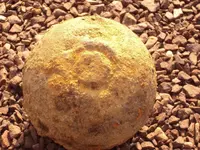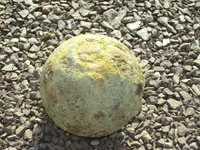Pro778 wrote:
> Is this a cannon ball?
> It weighs around 7 lbs. and is 3 7/8"
> Is the circular spot a fuse?
Thank you for providing accurate measurements of the ball's diameter and weight. There are literally multi-millions of metal balls which were not manufactured to be cannonballs. (For example: ball-bearings, Sports Shot Put balls, Ornamental Ironwork balls, and Stonemilling Industry rock-crusher balls.) So, accurate measurements are crucially necessary for determining whether a metal ball is a cannonball or not. Fortunately for modernday cannonball collectors & relic-diggers, various Historical documents recorded the very-precise size and weight of actual cannonballs used in America from the Revolutionary War through the Civil War. You can view the Historical very precise size-&-weight data (which is called the "Shot Tables") online, for free, at:
www.civilwarartillery.com/shottables.htm
The cannonball diameter-&-weight data in the Shot Tables charts shows not even a single match-up for you ball's diameter-&-weight, so your ball definitely is not a cannonball.
You asked "Is the circular spot a fuse?" The COMBINATION of your ball's diameter-&-weight (3-&-7/8-inches and 7 pounds) proves beyond any doubt that it is a Solid (not hollow) ball. So, even if your ball was a cannonball, it would be a Solid-Shot, which of course does not have a fuze.
Now about your ball's ID. We'll have to use "the process of elimination." Rock-crusher balls and ball-bearings do not have the circular spot. Your ball is too lightweight to be one of the Sports Shot Put ball Weight-classes (which are very-exactly 8.0 pounds, 10.0, 12.0, and 16.0 pounds). I've seen many Ornamental Ironwork balls -- such as a gatepost-top -- which have a circular hole for the mounting-rod. That rod is sometimes broken off, with the "stub" of it remaining in the hole. It can look very similar to the "circular spot" on your ball. That is the best guess I can make about what your ball is.





